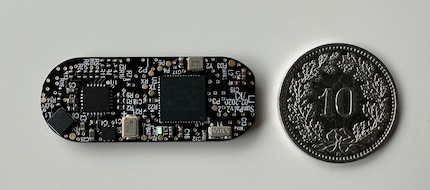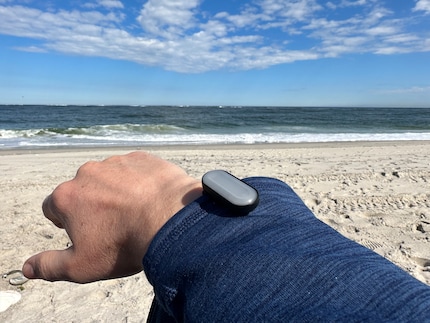
Product test
I’m single. Will this duvet help me sleep better?
by Pia Seidel

I’ve been trying to avoid getting sunburnt with a little help from some tech and a smart app. When I try out the gadget, produced by Swiss start-up Sun-a-Wear, I discover a few weaknesses. Nevertheless, I’d highly recommend it for sunny days.
UV rays are a real pain. Our skin needs the sun so that our bodies can form vital vitamin D. Too much sunshine, however, is a no-no. If our cells overdose on UV radiation, their repair mechanism will eventually fail, resulting in mutations as serious as cancer.
We humans tend to ignore warnings, especially ones prompting us to do things we don’t actually want to do. Feeling the warm rays on your skin is just too nice; lathering on the sun screen or finding shade just too much of a bother.
This is where the Swiss start-up Sun-a-Wear comes in. The company has designed a small sensor and a smart app intended to help you weigh up the benefits and dangers of the sun better – and give yourself the best possible protection. The sensor records UV exposure levels throughout the day, using the data to devise tips on how you can protect yourself, and let you know whether you’re at risk of sunburn. I’ve put the invention thoroughly through its paces.
The plastic case housing the technology is roughly the width of – and a centimetre shorter and thinner than – a AAA battery. To state the cold, hard facts, it’s 37 mm long, 17 mm wide and 10 mm high. Weighing in at four grammes, the sensor is extremely light.
When it comes to wearing it, I have two possible options. Either I can slide it onto a nylon wristband included with the product and wear it like a watch, or I can screw it into a clip, which I can slip onto an item of clothing. Unfortunately, both the clip and the wristband look slightly cheap. However, the clip in particular is astoundingly robust, surviving a few falls – including the time I got up and accidentally brushed it off myself.

Inside the housing, there’s a supercapacitor which stores power. I’ll spare you the chemical details of how this energy storage technology works. The important thing to be aware of is that’s it’s not a traditional battery requiring charging. The Sun-a-Wear supercapacitor draws its energy from the sun. It doesn’t need a whole lot of it as Bluetooth Low Energy is used for transmitting signals to your smartphone.
If your smartphone (and with it, the app) are temporarily out of range of the sensor, the sensor can save the data it’s recorded and send it to the app once the connection is restored. Here’s a typical use case. You’re at the lake or beach and want to go for a dip while wearing the sensor (that’s right, it’s waterproof). As you’re doing this, you leave your phone on the shore. Once you’re back on dry land, the sensor and app will reconnect.
A microprocessor situationally determines when the small supercapacitor receives and stores electricity via the built-in solar cell, and when it releases it for the Bluetooth connection or for measuring UV light. The makers of sun-o-wear have described the process clearly and in detail here.

As far as everyday use is concerned, this means I can take the sensor with me when I go jogging. I do, however, leave my smartphone at home, choosing instead to tackle my route with just my Apple Watch. This means the sensor’s tiny computer brain registers how much UV radiation it’s absorbed during my one-hour jog, without being connected to my smartphone. It then delivers this exact information to the app as soon as I’m back within range of my smartphone. I just have to remember to reconnect the sensor with my phone as soon as possible. If I forget, the UV radiation from my run won’t be counted against the amount I can tolerate, which would put my skin in danger.
Since both good and bad UV rays exist, the sensor also houses a light sensor for detecting the amount of radiation. Maths whizzes will now say that you can get the parts for the sensor for a few dollars, francs or euros, but that’s not entirely true. This is because components designed to generate energy from the sun usually cost significantly more than ones that rely on batteries for storage. Sun-a-Wear is also likely to have been hit by the steep rise in processor prices. An increase which, for small batch production, is disproportionate.
Even so, the material value alone certainly doesn’t justify the sensor’s price – as is almost always the case with any product. If you buy a Sun-a-Wear sensor, you don’t just get the hardware – you also get software that intelligently processes the sensor’s data.
At first glance, I’m bowled over with all the information the app offers. In addition to the settings, there are five different screens.
A cartoon-style sensor smiles away at me from the Start screen. Standing inside a circle, it shows how much UV exposure has been collected over the course of the day so far. At the bottom left, there’s a warning message for flagging up when it’s time to put on suncream and head into the shade. On the right, there’s information on the UV situation. This is where I find out how much more time I can spend in the sun. At the very bottom, there’s also an info element encouraging me to visit the Knowledge Base to find out more about UV radiation and its effects. Oh, and there’s also the current UV forecast at the top right. Whew, that’s a heck of a lot.

The second screen is the Live screen, which provides a UV forecast in the form of a line graph. Again, information is included on whether sun protection is advisable, and whether you’d better off going for a pair of sunglasses, a T-shirt, a hat, a patch of shade or some sunscreen.
The Analysis screen is for statistics buffs and chart enthusiasts; Sun-a-Wear has placed seven information tiles there. It allows me to see the cumulative data for a day, a week or a month. How often did I wear sunscreen? (Provided I’ve let the app know each time, of course.) Is my skin ageing slower or faster than that of the average person? How long was I exposed to good UV rays? And bad ones? Did I get enough UV light to produce vitamin D? How much time did I spend outdoors? It has answers for everything. Plus, the app encourages me to wear the sensor more often if I occasionally forget it. This is because the app is supposed to be more useful when there’s more available data.
I haven’t yet found the perfect spot on my clothes to wear the sensor. In T-shirt weather, I prefer simply slipping it onto my collar. Otherwise, I wear the wristband, even if it’s about as stylish as a dog’s tick collar.
If, however, I’m wearing long sleeves, the wristband is no longer an option. If my shirt slips over the sensor, the sun could burn me to a crisp without warning. When I wear it on the collar of my shirt, my head casts shadows over the sensor cell. Not only that, but I also have to constantly explain that I haven’t come straight from a TV interview and forgotten to take off my lapel mic. Too often, I just choose not to wear the sensor instead of thinking of the best place for it.
At the same time, these early summer days are exactly when the Sun-a-Wear could support me perfectly. With the skin not yet used to the sun, a light wind can easily make you forget its power. The result? Sunburn.
The UV sensor and the app don’t absolve you of responsibility for your own health. They «only» warn you if you’re catching too many bad UV rays. You can ignore it, but it’s better not to. On an Atlantic beach at the beginning of May, I found out the hard way that the app’s warnings really are accurate. Given the cool wind, I actually had a long T-shirt on, and so I felt safe. The sun, however, beamed fiercely down on the top of my balding head and on the backs of my hands. When evening set in, the result was red skin, on the brink of sunburn.

After this experience, I started wearing the sensor much more frequently, even though I kept having to think about where to put it. I rarely opened the app, which, to my tastes, was overloaded with information. Instead, I chose to rely on the push notifications sent to my smartphone. However, at the back of my mind, I was always aware that my actual UV dose might be higher than the measured one, because the sensor always requires a nearby smartphone. Alternatively, you can set your skin type as a few levels more sensitive. This way, Sun-a-Wear will warn you a little earlier.
In my opinion, the Sun-a-Wear has three issues:
Despite all this, I’d still recommend the sensor. It accurately measures UV radiation and uses it to calculate your UV exposure. Of course, weather apps also show you how strong the UV radiation is. However, when an app tells you to use sunscreen or put on a hat, it’s a whole other kettle of fish. To do this, Sun-a-Wear doesn’t force you to register and consent to the use of your data. Nor are you obliged to take out a subscription to use the app’s information; just pay once when you buy the sensor, and you get it all.
For around 80 francs or euros, that’s a lot of information and intelligent algorithms – data that’ll definitely encourage me to wear sunglasses, a hat and sunscreen more often than usual this summer. Even if it’s just because I’d rather see the app’s little cartoon sensor smile than laugh.
*Got any questions about the Sun-a-Wear? Go ahead and post a comment – I’ll be happy to answer.
Header image: Martin Jungfer
Journalist since 1997. Stopovers in Franconia (or the Franken region), Lake Constance, Obwalden, Nidwalden and Zurich. Father since 2014. Expert in editorial organisation and motivation. Focus on sustainability, home office tools, beautiful things for the home, creative toys and sports equipment.